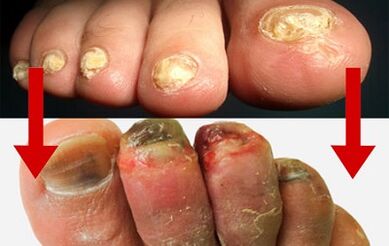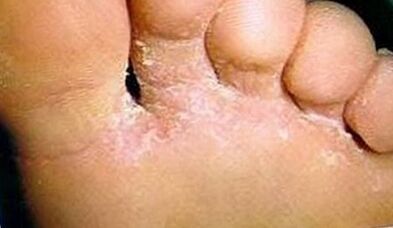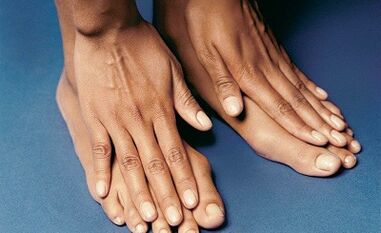Fungal lesion of the skin (yeast infection) between fingers and onychomycosis (nail plates) is an unpleasant and current infectious disease.
The British call for such a “athlete of the foot” pathology, because its development is associated with a erased constant, during training by feet and sweaty socks - an ideal environment for the development of yeast infections.
To judge by the fact that people are completely athletes, then each "athlete" is sick of mycoses of this form.And it is only according to official figures.Often, people are not in a hurry to ask for medical help from such "trifles", begin to "beat the drums" only when the pathology exacerbates and takes an extensive character.
Today, there are many effective ways to treat fungi between toes, including those at home.But you should know that the effectiveness of home remedies is noted with a complex treatment with drugs, and as an independent drug, only at the start of the pathological process.
Who is likely to be infected?

No one is immune to legs in the legs.Its development is predisposed to a warm and humid environment.They can be infected with them without even contacting the patient himself directly.Mycosis disputes have long lived in various objects, clothes and shoes.There are people predisposed to the fungus and not predisposed, who can be immune to fungal infection, even with frequent contact with infected objects.
The sensitivity factors are due to:
- A decrease in immune functions;
- The age and presence of chronic infections;
- Sweat stronger and a special composition of sweat, creating favorable terrain for the development of mycosis.
Intodallic fungi and onychomycosis are more often sensitive to people whose legs sweat constantly and at the same time, there are many cracks, ulcers and pustula wounds on their skin.This may not be facilitated in selected and quality shoes, excessive activity or frequent training, after which leg washing and the appropriate treatment of skin damage is often ignored.
The development of the disease is often affected by intestinal dysbiosis, pregnancy, states of varicose veins, flat feet and excess weight.
You can be infected with a fungus quickly, but quickly healing a fungus between the toes is quite problematic, because this process is long and you cannot do it alone with homemade remedies.
What does the inter -operative fungus look like?+ photo
The interdictal mycosis clinic depends on the stage of infection.
- In the weakly exposed and erased stadium from the disease, in the inter-return area of the legs, insignificant cracks and a light coat of the skin on the feet appear.Most often, cracks appear on the skin in the intervals of the third finger on the little finger.
- In the squamous-hyperkeratic stage, the skin rolls and the exfoliation of its upper layer begins.Yellow cors are formed on the fingers, itching and burning appear in the affected areas.
- The transition of the disease to the interginal stage is marked by swelling of the skin in the interdigital areas, the development of erosions caused by deep cracks.
- Bubble training appears at the dysthidrotic stage, accompanied by serious itching symptoms.

In addition to skin changes, from the second stage in the development of mycosis, the fungus affects the nails on the fingers.Their appearance is characterized by irregularities and growth, they are weighted, covered with scratches, gray or yellow spots.With the development of the disease, their condition worsens and "jewelry" increases size.
You can identify the presence of a fungus between the fingers with a very simple test yourself.It is necessary to make a warm solution of potassium permanganate with the lilac color, to immerse your legs and to resist a little.The skin on the feet will change the color to a darker tone and affected by the fungus will remain the same.
Treatment of fungi and legs of the nails at home, medicines and medications
Tightening with the treatment of nail fungi and between toes can cause the propagation of skin lesions on hips, buttocks, breast and abdomen.The therapeutic techniques of interdigital fungus of the legs and onychomycosis in the house are due to the use of various drugs selected according to the severity of the disease.Better still, if a doctor makes an appointment.
We do not know what effect the selected drugs will be called independently, it can be unpredictable.Before deciding an independent treatment, it is necessary to familiarize yourself carefully with the instructions and all the "underwater stones", the antifungal agent chosen.

The most effective drugs in leg mushrooms between the fingers are:
- A natural drug in the form of a gel gives a positive and high result with use at 3 times a day, from a week to a month.
- The tabblered shapes and in the form of suspensions are effective in the treatment of damage caused by the deep cracking of the skin, accompanied by erosion and purulent injuries.
- Antifungal ointments are applied to affected areas throughout the treatment period.
- Frequent wiping of affected skin (up to 3 to 5 times) alcohol solutions prevents mushroom growth.
- At the same time, shoes and socks are disinfected with adding.
Before the treatment of pathological processes on nail plates, it is necessary to soften them with a hot soda solution with domestic soap (30 grams of soda and 20 grams of soap per liter of water) within half an hour.
Such preparation provides a deeper introduction of medical drugs in the nail structure.After steam and drying, they proceed with drug manipulations.For this, they can be used:
- Special antifungal varnishes.
- Fungus nails.
- Spraying and solutions.
With an inter -man mushroom on the legs, the popular treatment, successfully periodic, are widely used to date in the form of baths, tablets and grass decoctions.
Folk remedies for the treatment of fungal damage
Folk healers recommend the use of baths with a different composition:
- With salt or ordinary sea and the addition of baking soda.Hot water - 3 liters, soda and 30 grams salt.Found the skin for 20 minutes, rinse, dry and put socks.
- Baths with the addition of vinegar in water.The solution must be strong.The procedural time is up to 10 minutes.The manipulations are made at night.
- Baths at night from a decoction of dandelion or iron wood leaves.50 gr.dry, or 300 gr.The fresh grass is brewed in 3 liters of water and insisted for half an hour.The time for the procedure is 20 minutes.
- Simple soda bicarbonate compress, slightly moistened with water.
- Compress from a suspension cooked from an egg, with a tablespoon of 5% vinegar and lift oil.
- Compress from a mixture of calendula, oak bark, verbena leaves and blackberries.Mix the equal proportions of dry ingredients, take 50 gr.Mixed herbs, pour 200 gr.boiling water and simmer over low heat for a quarter of an hour.Of a cooled decoction, make lotions.
With such manipulations, the skin generally occurs in affected areas - it must be carefully removed.
In order not to undergo infection, it is necessary to treat shoes and all clothes with vinegar (30%) or formalin (concentration of 25%), place them in a packaging and with 3 hours, then ventilate.
Nail and fingers prevention measures
To avoid infection, certain preventive measures must be observed.
- Use only practical shoes, preferably of high quality and natural materials.
- It is more often treated with disinfectants.
- Avoid examples and wear someone else's shoes.
- Prevention of legs after visiting baths, swimming pools and other public places.The simplest way in which the spores of the fungus go out is to wipe the legs with lemon.
- Maintain an immune system at the appropriate level - a balanced diet, saturated with vitamins.
- As an active prevention of interdictal mycosis - daily application to dry the problematic skin of a preventive ointment.
Respect for prevention measures will help prevent the development of a fungal infection or eliminate its relapse.
















